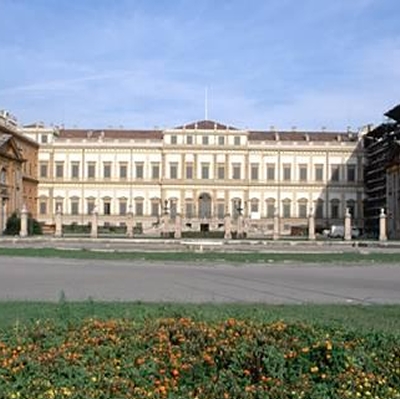Reggia di Monza
According to Paul the Deacon - the historian of the Longobards - Monza's mild climate had led the Ostrogoth king Theodoric the Great to have a place built in Monza, of which no certain trace has yet been found. At the time of the Longobards, Queen Theodelinda again favoured Monza, ordering the building not only of the oraculum, the origin of the future basilica, but also of a palace as a summer residence. The only surviving part of that prestigious building is the Longobard Tower, incorporated in the structure of the Cathedral. So there is a confirmed tradition of the presence of royal buildings in Monza.
First Austrian period
The lasting mildness of Monza's climate, combined with the force of its royal tradition - confirmed in Monza in later centuries by the permanent custody of the Iron Crown, symbol of the Kings of Italy, and by the coronation ceremonies - also le the Empress of Austria, Maria Theresa, to choose Monza, in 1777, as the site for the sumptuous summer residence of her second-youngest son, the Archduke Ferdinand of Habsburg-Este, whom she had appointed six years earlier as first general Governor of Austrian Lombardy. Designed by the imperial architect Giuseppe Piermarini - who trained with the famous Luigi Vanvitelli - the Palace, the Royal Gardens and the other connected buildings (Chapel, Orangerie and Rotonda) were in full use until 1796, when Italy was conquered by the armies of Napoleon Bonaparte.
French period
In 1805, Napoleon had himself crowned with the Iron Crown in Milan, proclaiming himself King of Italy. His stepson, Eugène de Beauharnais, whom he appointed Viceroy, occupied the Palace of Monza, around which he had an enormous Park laid out for hunting and - as desired by Napoleon - for the organization of a model farming estate. The design of the enormous park was entrusted to the Swiss architect Luigi Canonica, who also carried out the construction work of the double enclosure, of the gatehouses, and of the Theatre. Some stones from the demolished Visconti walls were used for the enclosure of the Park.
Second Austrian period
In 1818, after the defeat of Napoleon, Lombardy and, with it, the Palace of Monza, returned into Austrian hands: first those of the Viceroy of the new Kingdom of Lombardy–Venetia; then, in 1848, into those of Marshal Radetsky, commander in chief of the imperial army in Italy. Lastly, for a short time, the future unfortunate emperor of Mexico, Maximilian I, stayed at the Palace.
Savoia period
The annexation of Lombardy–Venetia to the Kingdom of Piedmont brought the Palace into the hands of the House of Savoia. The splendid building was used especially by Umberto I, until his assassination by the anarchist Gaetano Bresci, in 1900, just close to the Park entrance. Umberto's son, Victor Emmanuel III, had the Palace closed and it was not used again until its restoration, which was begun in 2003 and completed on 26 June 2014.
The Palace of Monza today
Today the Royal Palace in Monza is an exhibition centre, as at EXPO 2015, for events of the greatest international importance. The buildings and the park are open to the public, offering a series of interesting itineraries for visitors.
Contact info
- Viale Brianza,1 20052 Monza
- Lat 45.59336317970435, Long 9.274840831756592
- +39 039 394641
- +39 039 39464231
- http://www.reggiadimonza.it/
- comunicazione@reggiadimonza.it

